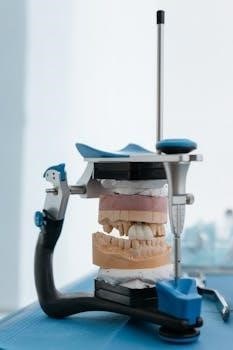Delta Dental PPO Coverage Overview for 2024
Delta Dental PPO plans for 2024 offer a comprehensive range of dental benefits, emphasizing in-network savings. These plans provide access to a large network of dentists, aiming to reduce out-of-pocket costs. Members are encouraged to use PPO dentists to maximize their benefits, with most services covered at a percentage.
Delta Dental PPO Network and In-Network Benefits
The Delta Dental PPO network is a key component of the plan, offering access to a broad range of dentists who have agreed to provide services at negotiated rates. This in-network structure is designed to help members save money on dental care. When you choose a dentist within the Delta Dental PPO network, you’ll generally experience lower out-of-pocket costs due to these pre-established fee agreements. In-network benefits are typically paid at a higher percentage compared to out-of-network services, further enhancing the value of utilizing network dentists. This encourages members to seek care from participating providers, ensuring they receive maximum coverage. The network includes a variety of dental professionals, from general dentists to specialists, catering to a range of dental needs. Delta Dental PPO network dentists are credentialed, ensuring they meet quality standards. Choosing an in-network provider not only helps with cost savings but also provides the assurance of receiving care from a qualified professional. It’s important for members to confirm their dentist’s participation in the PPO network to fully leverage these benefits. You can usually verify network participation through the Delta Dental website or by contacting customer service. By staying within the network, members can avoid balance billing, which is where a dentist bills for the difference between their charge and the allowed amount. This is a significant advantage of utilizing in-network benefits.
Out-of-Network Coverage and Benefit Levels
While the Delta Dental PPO plan encourages the use of in-network providers, it also offers some coverage for out-of-network dental care. However, it’s important to understand that out-of-network benefits are typically paid at a lower level compared to in-network services. This means that members who choose to see an out-of-network dentist will likely pay a higher percentage of the cost out of pocket. The specific benefit level for out-of-network care can vary, but generally, the plan will cover a smaller portion of the total charges. Additionally, out-of-network dentists may not have agreed to the same fee schedule as in-network providers, which can result in higher overall costs for the member. Unlike in-network dentists, out-of-network providers are not bound by negotiated rates, potentially leading to balance billing, where the member is responsible for the difference between the dentist’s charge and the amount the insurance covers. Therefore, while the plan does offer out-of-network coverage, it is generally more cost-effective for members to utilize in-network providers. Understanding the specific out-of-network benefit levels and potential costs is crucial when making decisions about dental care. Members should review their plan documents carefully to understand the extent of out-of-network coverage and plan accordingly to minimize their expenses.
Delta Dental PPO Benefit Summary⁚ Key Features
The Delta Dental PPO plan for 2024 boasts several key features designed to provide comprehensive and cost-effective dental care. A primary benefit is the emphasis on in-network providers, where members can maximize their savings. The plan typically offers a higher percentage of coverage for services received from dentists within the Delta Dental PPO network, encouraging members to choose from this extensive list. Another notable feature is the potential for enhanced benefits for members who have received at least one routine cleaning or oral exam within the past 12 months, promoting preventative care. The plan also includes coverage for basic procedures, though these may be covered at a lower percentage if performed by a Premier or non-Delta Dental dentist. In addition, members are generally held harmless from balance billing when using in-network providers, meaning they will not be charged the difference between the dentist’s billed amount and the Delta Dental PPO fee. While out-of-network care is also covered, it typically comes with a lower level of benefits and could involve higher out-of-pocket expenses. The PPO plan aims to deliver quality dental care while keeping costs manageable for its members, with a focus on preventative services and in-network utilization. The specific details, including maximums and deductibles, are an important aspect of understanding the overall value of the plan.

2024 Delta Dental PPO Plan Maximums and Deductibles
Understanding the maximums and deductibles associated with the 2024 Delta Dental PPO plan is crucial for effective financial planning regarding dental care. Generally, these plans include an annual maximum benefit amount, which is the total sum the plan will pay out for covered dental services within a benefit year. This maximum can vary, some plans feature a $1,000 maximum, while others may offer higher limits such as $1,750. Some plans may have unlimited annual maximums for in-network services. It’s imperative to review your specific plan documents for exact details as these can vary by state and specific plan offering. Deductibles are also a key component; these are the amounts you must pay out-of-pocket before the plan starts covering its portion of dental costs. Some plans may have individual and family deductibles; For some plans, deductibles for in-network services may be lower or even waived, particularly for certain preventative care services. It is important to note that deductibles may not apply to all services, like routine check-ups and cleanings. The specific deductible amounts and how they apply will be outlined in your plan documents and should be carefully reviewed to understand your financial responsibility for dental care.
Preventive Services Coverage within Delta Dental PPO
Delta Dental PPO plans in 2024 place a strong emphasis on preventive dental care, aiming to promote oral health and reduce the need for more extensive treatments. These plans commonly provide full coverage, often at 100%, for a range of preventive services when utilizing an in-network dentist. These services typically encompass routine dental check-ups, including periodic examinations by a dentist, and regular dental cleanings. Additionally, coverage generally extends to diagnostic services such as x-rays, which are essential for identifying potential dental issues early. Fluoride treatments, which can help prevent cavities, are often included as a covered preventive service, especially for children. Some plans may also cover sealants, which provide a protective barrier on teeth to prevent decay. Importantly, many Delta Dental PPO plans do not apply deductibles to preventive services, meaning that you may not have to meet a deductible before these services are covered. This encourages members to seek regular preventive care. For a complete understanding of what preventive services are covered and at what level of coverage, it’s imperative to consult the specific plan documents.

Delta Dental PPO vs. Delta Dental Premier
When comparing Delta Dental PPO and Delta Dental Premier plans, key differences emerge primarily in network access and cost. Delta Dental PPO plans are characterized by a more extensive network of dentists, and typically provide the highest level of benefits when these in-network dentists are utilized. Members usually experience lower out-of-pocket expenses when they visit a PPO dentist, as these dentists have agreed to contracted fees. In contrast, Delta Dental Premier plans offer a broader choice of dentists, including those within the PPO network and others who have agreed to Delta Dental’s Premier fee schedules. While Premier plans offer more flexibility in choosing a dentist, the benefit levels for out-of-network dentists may be lower than those offered by PPO plans. With Premier, you might have to pay more if you see a dentist outside of the PPO network. The Delta Dental PPO plan prioritizes cost savings through a narrow network, while Delta Dental Premier prioritizes more choice, often at a somewhat higher cost for out-of-network providers. It is important to check your specific plan for exact coverage details.

Understanding Delta Dental PPO Claim Processing

Delta Dental PPO claim processing generally involves a streamlined process, especially when using in-network providers. When you visit a Delta Dental PPO dentist, they usually submit claims directly to Delta Dental on your behalf. This direct claim submission simplifies the process and minimizes your involvement. Delta Dental then processes the claim according to your plan’s benefits and fee schedules. For in-network services, Delta Dental pays the contracted fee directly to the dentist, and you are only responsible for any co-pays, deductibles, or coinsurance amounts. In cases where you see an out-of-network dentist, you might need to pay the dentist upfront and then submit a claim to Delta Dental for reimbursement. It’s crucial to keep all receipts and necessary paperwork when submitting claims yourself. Delta Dental will then process the out-of-network claim based on your plan’s out-of-network benefit levels, which are usually lower than in-network benefits. Understanding your plan’s specific claim processing procedures can help avoid delays or incorrect payments. Always check your plan documents for specific claim submission instructions and time limits.
Accessing Delta Dental PPO Plan Documents and Information
Accessing your Delta Dental PPO plan documents and information is crucial for understanding your coverage. Typically, Delta Dental provides plan documents and resources through various channels. The primary source is often their official website, where you can usually log in to your account to access your specific plan details, benefit summaries, and other relevant documentation. These documents, often in PDF format, outline your coverage, including deductibles, co-pays, coinsurance, and annual maximums. You may also find a directory of PPO network dentists on the website, which is essential for maximizing your benefits. Additionally, Delta Dental may send plan information via email, or you can request a copy by contacting their customer service. It’s wise to review your plan documents carefully to understand your specific coverage and claim processing procedures. If you have any questions, Delta Dental’s customer service representatives are available to provide assistance via phone or email. Keeping your contact information up-to-date with Delta Dental ensures that you receive timely notifications and plan updates. Some employers may also provide plan information through their benefits portal.
State-Specific Variations in Delta Dental PPO Plans
It’s important to recognize that Delta Dental PPO plans can exhibit variations depending on the state in which they are offered. These state-specific differences can affect a variety of aspects, including the network of participating dentists, the specific benefits offered, and even the cost of the plan. For example, a Delta Dental PPO plan in one state might have a larger network of dentists compared to a plan in another state. Benefit levels, such as the percentage covered for certain procedures and annual maximums, may also differ. Furthermore, the waiting periods for certain types of coverage, such as orthodontics, can also vary by state. Understanding these state-specific nuances is essential to making informed decisions about your dental coverage. To accurately assess your specific plan, refer to the plan documents provided by Delta Dental in your state. These documents should detail the specific benefits and limitations applicable to your location. Additionally, state regulations and mandates can impact plan design and coverage requirements. Therefore, always consult the details of your state-specific plan to ensure you have an accurate understanding of your dental coverage.
